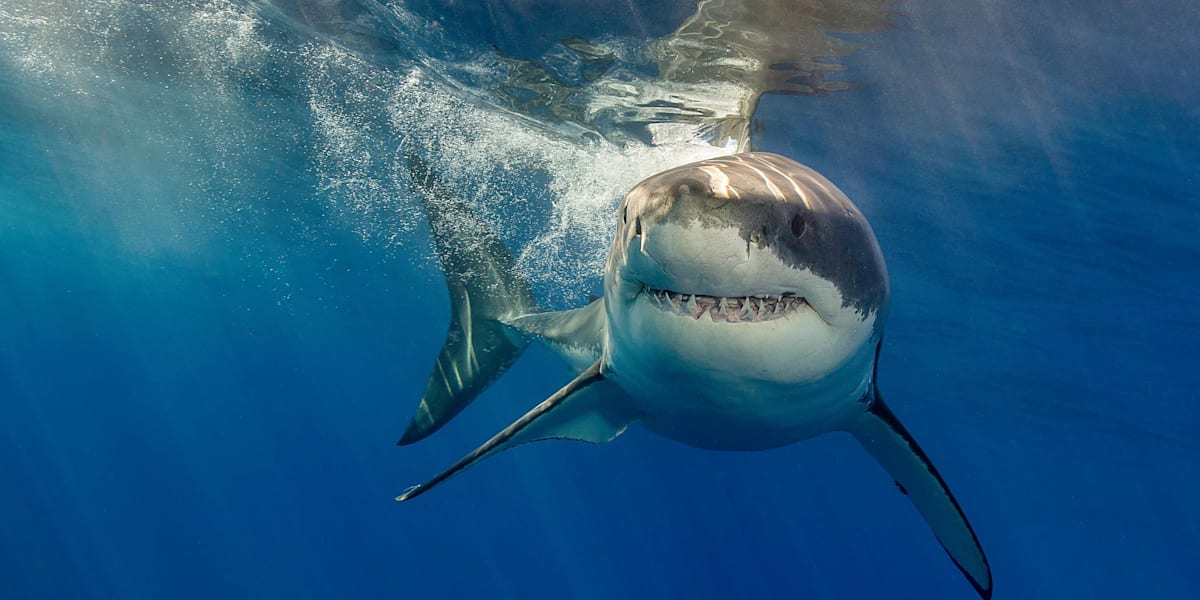A great white shark can swim at speeds up to 25 miles per hour. This impressive speed aids in hunting and evasion.
Great white sharks are among the ocean’s most formidable predators. Their streamlined bodies and powerful tails allow them to reach remarkable speeds. This swift movement is crucial for capturing prey like seals and fish. Great white sharks are not only fast but also highly efficient hunters.
They use their speed to ambush and surprise their targets. This agility also helps them avoid potential threats in their environment. Understanding their swimming capabilities provides insight into their survival strategies. These magnificent creatures are a testament to the incredible adaptations of marine life. Their speed underscores their role as apex predators in the ocean.

Credit: www.redbull.com
Introduction To Great White Sharks
Great white sharks are among the most fascinating marine creatures. Known for their size and power, they rule the ocean. These sharks are a marvel of nature with incredible speed.
Physical Characteristics
Great white sharks have a robust, torpedo-shaped body. Their color is gray on top and white underneath. This helps them blend with the ocean. They can grow up to 20 feet long and weigh over 5,000 pounds.
Their teeth are serrated and razor-sharp. These teeth are perfect for tearing through prey. They have several rows of teeth, which are constantly replaced.
Habitat And Distribution
Great white sharks are found in coastal waters all over the world. They prefer cooler waters, usually between 54 and 75 degrees Fahrenheit.
Here are some regions where they are commonly found:
- California Coast
- South Africa
- Australia
- Northeastern United States
They migrate to follow their prey and to breed. These migrations can cover thousands of miles.

Credit: ocean.si.edu
Anatomy And Speed
The great white shark is one of the ocean’s fastest predators. Its speed is due to unique anatomical features. Let’s explore the muscle structure and tail and fin design of this amazing creature.
Muscle Structure
The great white shark has powerful muscles. These muscles are called red muscles and white muscles. Red muscles help with continuous swimming. They are rich in blood vessels and oxygen.
White muscles are for sudden bursts of speed. They tire quickly but provide a lot of power. This combination allows the shark to swim both fast and long distances.
Tail And Fin Design
The great white shark’s tail is called a caudal fin. It has a unique shape known as heterocercal. The top lobe is longer than the bottom lobe.
This design helps the shark move swiftly. The pectoral fins are large and strong. They provide balance and lift, making the shark agile.
| Feature | Function |
|---|---|
| Red Muscles | Continuous swimming |
| White Muscles | Sudden bursts of speed |
| Heterocercal Tail | Swift movement |
| Pectoral Fins | Balance and lift |
These features make the great white shark a top predator. Its speed and agility are unmatched in the ocean.
Comparative Speeds
Understanding the comparative speeds of marine creatures is fascinating. Among them, the Great White Shark stands out. This section explores how fast it swims compared to other marine species.
Other Shark Species
The Great White Shark is not the only fast swimmer. Other shark species also show impressive speeds. Here are some comparisons:
| Shark Species | Top Speed (mph) |
|---|---|
| Great White Shark | 25 |
| Shortfin Mako Shark | 45 |
| Blue Shark | 24.5 |
Marine Predators
Comparing the speeds of the Great White Shark to other marine predators is interesting. Here are a few notable examples:
| Marine Predator | Top Speed (mph) |
|---|---|
| Orca (Killer Whale) | 34 |
| Common Dolphin | 60 |
| Tuna | 47 |
The Great White Shark is fast, but some marine predators are faster. These comparisons show the diverse and impressive speeds in the ocean.

Credit: www.iflscience.com
Factors Influencing Speed
The speed of a great white shark is influenced by several factors. These factors include their hunting techniques and environmental conditions. Understanding these factors can help explain how these predators move so swiftly in the water.
Hunting Techniques
Great white sharks use specific hunting techniques to catch prey. They rely on their powerful tails for rapid acceleration. The tail’s strong muscles propel them forward quickly. Sharks often use a technique called the “burst attack.” This involves a sudden, high-speed sprint towards their target. Their streamlined bodies reduce water resistance, allowing faster movement. They also have special muscles that store energy for quick bursts. These muscles are called “red muscles” and are rich in oxygen. This helps them move faster over short distances.
Environmental Conditions
Environmental conditions play a crucial role in shark speed. Water temperature is a significant factor. Warmer waters can increase their muscle efficiency. This makes them swim faster. The clarity of water also affects their speed. In clear water, they can spot prey from a distance and accelerate quickly. Ocean currents can either aid or hinder their movement. A strong current can push them forward, increasing their speed. Conversely, swimming against a current can slow them down.
The table below summarizes the key factors influencing the speed of great white sharks:
| Factor | Impact on Speed |
|---|---|
| Hunting Techniques | Increases speed during bursts |
| Water Temperature | Higher temperatures improve muscle efficiency |
| Water Clarity | Clear water aids in spotting prey quickly |
| Ocean Currents | Strong currents can boost or reduce speed |
Understanding these factors helps in appreciating the speed and agility of great white sharks. These majestic predators have evolved to be swift and efficient hunters in their oceanic environment.
Research And Observations
The speed of a great white shark has fascinated scientists for years. Understanding how fast they swim helps in conservation and study efforts. Researchers use various methods to measure these speeds accurately.
Tracking Methods
Scientists employ several tracking methods to study great white sharks. These methods offer a deeper understanding of their swimming speeds.
- Satellite Tags: These tags send data to satellites, providing real-time location updates.
- Acoustic Tags: These tags emit sound waves, which are picked up by underwater receivers.
- Direct Observation: Researchers follow sharks using boats and underwater cameras.
Notable Studies
Several studies have provided insights into the swimming speeds of great white sharks. Here are some key findings:
| Study | Year | Speed Recorded |
|---|---|---|
| California Shark Research Project | 2012 | 25 mph |
| South African Coastal Study | 2015 | 22 mph |
| Australian Marine Research | 2018 | 23 mph |
These studies help us understand the incredible speeds of great white sharks. They also aid in formulating conservation strategies to protect these majestic creatures.
Frequently Asked Questions
How Fast Can A Great White Shark Swim?
Great white sharks can swim at speeds of up to 25 mph. This impressive speed helps them catch fast-moving prey. They can maintain this speed for short bursts.
What Factors Affect A Great White Shark’s Speed?
Several factors affect a great white shark’s speed, including water temperature, age, and size. Warmer waters can make them swim faster. Younger sharks are generally quicker.
How Does A Great White Shark’s Body Help It Swim Fast?
A great white shark’s streamlined body reduces drag, enabling swift movement. Its powerful tail fin provides propulsion. Muscle structure also aids in rapid bursts of speed.
Are Great White Sharks The Fastest Sharks?
No, great white sharks are not the fastest sharks. The shortfin mako shark holds that title, reaching speeds up to 45 mph. However, great whites are still among the fastest.
Conclusion
Understanding the speed of great white sharks highlights their incredible hunting abilities. These apex predators can swim up to 25 miles per hour. Their swift movements ensure they remain top predators in the ocean. Fascination with their speed continues to grow.
Keep exploring to uncover more about these magnificent creatures.
